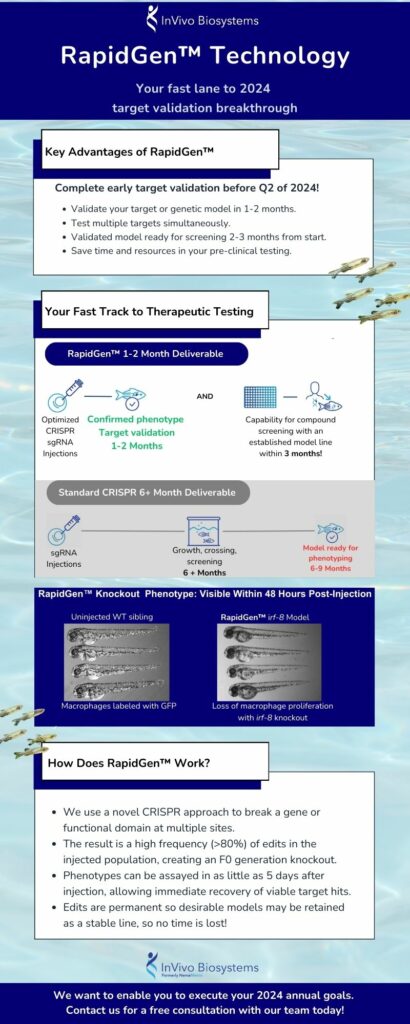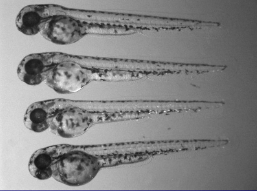RapidGen™ - Your fast lane to 2024 target validation breakthrough
Knock-Out your drug development efforts in 2024
Our RapidGen™ technology executes proof-of-concept or viability testing of your pre-clinical drug model in about a month. Our industry experts utilize a revolutionary CRISPR approach to break a gene or functional domain at multiple sites, followed by rapid phenotypic assays to immediately recover viable target hits. This method, which involves targeted double-strand breaks, enables the formation of loss-of-function mutations and the generation of knock-out lines (KO lines) that are essential for understanding the function mutation impacts and behavioral phenotypes in disease models.Save your time and resources with our new RapidGen™ model
Our novel approach to utilizing zebrafish as a disease model for drug development provides our valued customers with early decision-making regarding their new functional genetic model. The use of transgenic lines and mutagenesis rate analysis in zebrafish allows for the precise identification of mutant alleles and function phenotypes, making it a choice for target site validation in the research community. Our technology facilitates the generation of zebrafish lines with specific KO-induced phenotypes, including teratogenic phenotypes, which are crucial for the assessment of drug safety and efficacy. Error-prone mechanisms associated with CRISPR editing are meticulously managed to ensure high-quality method descriptions and options for target site validation. The alleles in zebrafish serve as an ideal system for observing the formation of stable mutant lines and the double-strand break repair processes, enhancing our understanding of gene function and its implications for drug discovery. Furthermore, our effective F0 knockout method ensures the rapid generation of mutant fish with desired target effects at the one-cell stage embryos, enhancing the precision of our approach in identifying complex phenotypes. Our RapidGen™ technology also incorporates efficient methods to analyze target sites for CRISPR efficiency, utilizing confocal images to capture the intricate details of protein structure and mutant phenotypes. This is particularly useful in studying cell-autonomous functions and target activity, which are vital in understanding biological processes under various experimental conditions. See our infographic here summarizing the key competitive advantage our RapidGen™ service offers as you are mapping out your pre-clinical drug development timeline goals. RapidGen™ Technology Infographic
Want to learn more about RapidGen™?
Visit the following resources to get up to speed on our state-of-the-art technology:
RapidGen Fish Model | InVivo Biosystems
Crispants – Rapid Zebrafish Genetic Model Creation (invivobiosystems.com)
How Gene Data Sheds Light on Epilipesy (invivobiosystems.com)
Contact Our Experts Today
We are dedicated to assisting you in your pre-clinical drug development efforts.



